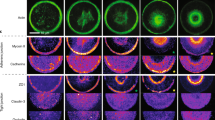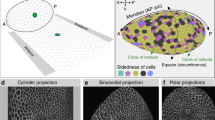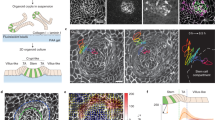Abstract
The de novo formation of secretory lumens plays an important role during organogenesis. It involves the establishment of a cellular apical pole1 and the elongation of luminal cavities2. The molecular parameters controlling cell polarization have been heavily scrutinized3,4,5. In particular, signalling from the extracellular matrix (ECM) proved essential to the proper localization of the apical pole by directed protein transport6. However, little is known about the regulation of the shape and the directional development of lumen into tubes. We demonstrate that the spatial scaffolding of cells by ECM can control tube shapes and can direct their elongation. We developed a minimal organ approach comprising of hepatocyte doublets cultured in artificial microniches to precisely control the spatial organization of cellular adhesions in three dimensions. This approach revealed a mechanism by which the spatial repartition of integrin-based adhesion can elicit an anisotropic intercellular mechanical stress guiding the osmotically driven elongation of lumens in the direction of minimal tension. This mechanical guidance accounts for the different morphologies of lumen in various microenvironmental conditions.
This is a preview of subscription content, access via your institution
Access options
Subscribe to this journal
Receive 12 print issues and online access
$209.00 per year
only $17.42 per issue
Buy this article
- Purchase on Springer Link
- Instant access to full article PDF
Prices may be subject to local taxes which are calculated during checkout





Similar content being viewed by others
References
Bryant, D. M. & Mostov, K. E. From cells to organs: building polarized tissue. Nat. Rev. Mol. Cell Biol. 9, 887–901 (2008).
Lubarsky, B. & Krasnow, M. A. Tube morphogenesis: making and shaping biological tubes. Cell 112, 19–28 (2003).
Bayless, K. J. & Davis, G. E. The Cdc42 and Rac1 GTPases are required for capillary lumen formation in three-dimensional extracellular matrices. J. Cell Sci. 115, 1123–1136 (2002).
Levi, B. P., Ghabrial, A. S. & Krasnow, M. A. Drosophila talin and integrin genes are required for maintenance of tracheal terminal branches and luminal organization. Development 133, 2383–2393 (2006).
Iruela-Arispe, M. L. & Davis, G. E. Cellular and molecular mechanisms of vascular lumen formation. Dev. Cell 16, 222–231 (2009).
Yu, W. et al. Beta1-integrin orients epithelial polarity via Rac1 and laminin. Mol. Biol. Cell 16, 433–445 (2005).
Sawyer, J. M. et al. Apical constriction: a cell shape change that can drive morphogenesis. Dev. Biol. 341, 5–19 (2010).
Debnath, J. et al. The role of apoptosis in creating and maintaining luminal space within normal and oncogene-expressing mammary acini. Cell 111, 29–40 (2002).
Martin-Belmonte, F. et al. Cell-polarity dynamics controls the mechanism of lumen formation in epithelial morphogenesis. Curr. Biol. 18, 507–513 (2008).
Martín-Belmonte, F. & Rodríguez-Fraticelli, A. E. Acquisition of membrane polarity in epithelial tube formation patterns, signaling pathways, molecular mechanisms, and disease. Int. Rev. Cell Mol. Biol. 274, 129–182 (2009).
Herwig, L. et al. Distinct cellular mechanisms of blood vessel fusion in the zebrafish embryo. Curr. Biol. 21, 1942–1948 (2011).
Kamei, M. et al. Endothelial tubes assemble from intracellular vacuoles in vivo. Nature 442, 453–456 (2006).
Bryant, D. M. et al. A molecular switch for the orientation of epithelial cell polarization. Dev. Cell 31, 171–187 (2014).
Treyer, A. & Musch, A. Hepatocyte polarity. Compr. Physiol. 3, 243–287 (2013).
Schlosser, S. F., Burgstahler, A. D. & Nathanson, M. H. Isolated rat hepatocytes can signal to other hepatocytes and bile duct cells by release of nucleotides. Proc. Natl Acad. Sci. USA 93, 9948–9953 (1996).
Zong, Y. et al. Notch signaling controls liver development by regulating biliary differentiation. Development 136, 1727–1739 (2009).
Fu, D., Wakabayashi, Y., Lippincott-Schwartz, J. & Arias, I. M. Bile acid stimulates hepatocyte polarization through a cAMP-Epac-MEK-LKB1-AMPK pathway. Proc. Natl Acad. Sci. USA 108, 1403–1408 (2011).
Jungermann, K. & Kietzmann, T. Oxygen: modulator of metabolic zonation and disease of the liver. Hepatology 31, 255–260 (2000).
Gimenes, D. et al. Liver parenchyma heterogeneity in the response to extracellular NAD + . Cell Biochem. Funct. 24, 313–325 (2006).
Sperber, I. Secretion of organic anions in the formation of urine and bile. Pharmacol. Rev. 11, 109–134 (1959).
Boyer, J. L. Bile formation and secretion. Compr. Physiol. 3, 1035–1078 (2013).
Larocca, M. C., Soria, L. R., Espelt, M. V., Lehmann, G. L. & Marinelli, R. A. Knockdown of hepatocyte aquaporin-8 by RNA interference induces defective bile canalicular water transport. Am. J. Physiol. Gastroint. Liver Physiol. 296, G93–100 (2009).
Marinelli, R. A., Lehmann, G. L., Soria, L. R. & Marchissio, M. J. Hepatocyte aquaporins in bile formation and cholestasis. Front. Biosci. 16, 2642–2652 (2011).
Wang, T., Yanger, K., Stanger, B. Z., Cassio, D. & Bi, E. Cytokinesis defines a spatial landmark for hepatocyte polarization and apical lumen formation. J. Cell Sci. 127, 2483–2492 (2014).
Tsukada, N., Ackerley, C. A. & Phillips, M. J. The structure and organization of the bile canalicular cytoskeleton with special reference to actin and actin-binding proteins. Hepatology 21, 1106–1113 (1995).
Tuschl, G., Hrach, J., Walter, Y., Hewitt, P. G. & Mueller, S. O. Serum-free collagen sandwich cultures of adult rat hepatocytes maintain liver-like properties long term: a valuable model for in vitro toxicity and drug-drug interaction studies. Chem. Biol. Interact. 181, 124–137 (2009).
Hall, H. G., Farson, D. A. & Bissell, M. J. Lumen formation by epithelial cell lines in response to collagen overlay: a morphogenetic model in culture. Proc. Natl Acad. Sci. USA 79, 4672–4676 (1982).
Bryant, D. M. et al. A molecular switch for the orientation of epithelial cell polarization. Dev. Cell 31, 171–187 (2014).
Akhtar, N. & Streuli, C. H. An integrin–ILK–microtubule network orients cell polarity and lumen formation in glandular epithelium. Nat. Cell Biol. 15, 17–27 (2013).
Rodriguez-Fraticelli, A. E., Auzan, M., Alonso, M. A., Bornens, M. & Martin-Belmonte, F. Cell confinement controls centrosome positioning and lumen initiation during epithelial morphogenesis. J. Cell Biol. 198, 1011–1023 (2012).
Rodriguez-Fraticelli, A. E. & Martin-Belmonte, F. Mechanical control of epithelial lumen formation. Small GTPases 4, 136–140 (2013).
Engl, W., Arasi, B., Yap, L. L., Thiery, J. P. & Viasnoff, V. Actin dynamics modulate mechanosensitive immobilization of E-cadherin at adherens junctions. Nat. Cell Biol. 16, 587–594 (2014).
Dunn, J. C., Tompkins, R. G. & Yarmush, M. L. Long-term in vitro function of adult hepatocytes in a collagen sandwich configuration. Biotechnol. Prog. 7, 237–245 (1991).
Yeh, T. H. et al. Liver-specific β-catenin knockout mice have bile canalicular abnormalities, bile secretory defect, and intrahepatic cholestasis. Hepatology 52, 1410–1419 (2010).
Herr, K. J. et al. Loss of α-catenin elicits a cholestatic response and impairs liver regeneration. Sci. Rep. 4, 6835–6835 (2014).
Masters, T. et al. Easy fabrication of thin membranes with through holes: application to protein patterning. PLoS ONE 7, e44261 (2012).
Quistorff, B., Dich, J. & Grunnet, N. in Methods in Molecular Biology Vol. 5 (eds Pollard, J. W. & Walker, J. M.) Ch. 14, 151–160 (Humana, 1990).
Acknowledgements
The authors thank S. Wolf, A. Wong and L. Bulavina for their help with manuscript writing and illustration. We thank J. J. Fan and S. Mo for in vivo imaging. We thank T. Saunders and R. Zaidel-Bar for insightful comments on the manuscripts. This work was supported mostly by MBI and IBN core funding, NRF grant CRP 001-084, and ANR grant Defis generique 2014.
Author information
Authors and Affiliations
Contributions
Q.L. and Y.Z. performed most of the experiments. Q.L., Y.Z. and V.V. designed the experiments. H.Y. and V.V. initiated the work. J.R., P.P., M.M., K.H., J.-P.T. and H.Y. contributed substantially in helping the realization of the experiments. V.V. and H.Y. jointly supervised the work of Q.L. Q.L., Y.Z. and V.V. wrote the article.
Corresponding author
Ethics declarations
Competing interests
The authors declare no competing financial interests.
Integrated supplementary information
Supplementary Figure 1 Fabrication of microcavities with biomimetic interfaces.
(A) A PDMS stamp is micro molded on a silicon wafer displaying micro-features (30 × 30 × 30 μm) formed by standard fabrication protocols for SU8 (step 1). The stamp is placed on a flat PDMS sheet and the gaps are filled by capillarity (step 2) with a UV prepolymer mix (NoA 74 from Norland Adhesive). After UV curing, the stamp is removed (step 3) and the NoA Membrane is incubated in a solution of proteins that will eventually coat the sides of the wells (step 4). The membrane is rinsed, dried (step 5) and flipped (step 6) onto a glass slide pre coated with the protein to be localized at the bottom of the wells (step 7). Finally, Pluronic acid is used to passivate the top of the wells (step 8). The membrane is eventually immersed in the cell culture medium without drying (step 9). (B) The 3D microwell culture system. Left: the membrane with microwell (1X1 cm) is placed at the glass bottom of a 35mm diameter glass dish. scale bar = 1 cm. Middle: DIC image of hepatocytes cultured in microwells. Scale bar = 100 μm. Right: Example of selective protein coating. 3 labeled BSA are coated on the bottom (Alexa 633 conjugate), side (Alexa 555 conjugate) and top (Alexa 488 conjugate) of the well as described in Methods. Scale bar = 5 μm.
Supplementary Figure 2 Biomimetic interfaces can be maintained during cell culture.
(A) Immunolabeling of ECM deposition and remodeling on the side and bottom of the wells. Fibronectin was stained prior cell seeding and after 2 days of cell culture in the wells coated in various configurations. All microwells are initially coated with fibronectin on their base. Their side coating are, from left to right, pluronic acid (P/F), polylysine (PL/F), E-Cadherin(Ecad/F), fibronectin (F/F). We observed a remodeling of the coated fibronectin at the bottom of the well that does not preclude the proper adhesion of the cells on that substrate. Pluronics and E-cad coating do not allow secreted ECM proteins to be deposited. However, Polylysine primed the deposition of the secreted matrix. Fibronectin was also detected inside the cell body but it was not taken into account for further quantification. Scale bar = 5 μm. (B) Quantification of fibronectin on the side in P/F without cells (n = 30 wells), P/F (n = 35 wells), PL/F (n = 39 wells), Ecad/F (n = 43 wells) with cells and F/F without cells (n = 28 wells), F/F with cells (n = 20wells) 48 hours after cell seeding. In P/F configuration, the amount of fibronectin keeps at background level due to the passivation of Pluronic acid, while in PL/F configuration, endogenous fibronectin secreted by hepatocytes accumulated on the wall possibly as a result of the adhesion of cells facilitated by polylysine at beginning. In Ecad/F configuration, a slight accumulation of fibronectin at the top of well has been observed, while the main part of wall is free of fibronectin because of occupation of Ecadherin. In the F/F configuration, the level of fibronectin remains high. The quantification indicates that we can control the spatial distribution of ECM or other adhesion side (such as Ecadherin) based on the materials used to coating the surface. (∗∗∗ indicates Student’s t-test p < 0.001).
Supplementary Figure 3 Cell survival and polarization maintenance in the artificial microniches.
(A) Bright field image of microwells filed with hepatocytes. Doublets with at least one cell positive to Propidium Iodide staining were counted as dead (left). Doublets positive to cholyl-lysyl-fluorescein, a fluorescent bile salt, were counted as functional canaliculi (right). (B) The number of the microwells with live cells and the number of the microwells with functional canaliculi over 4 days were normalized by the number of the microwells with cells or by the number of total microwells. Nl is the number of occupied microwells without any dead cells. Nf is the number of microwells with functional canaliculi. No is the number of microwells occupied by cells. Nt is the number of total microwells. Cell viability and functionality was assured over at least 4 days. Nl, Nf and Nt were all equal to 600 individual doublets in microwells. We gathered data from 2 batches coming from three different rats leading to about 200 doublets each. (C) Typical top views of canaliculi stained with F-actin and ZO-1 (left panel) or MRP2 (right panel) in microwells in F/F and P/F configurations. Hepatocytes could successfully be cultured over 4 days without substantial loss to function, polarization and proper localization of transporter. We concluded that our system constitutes bona fide niches for hepatocyte culture. We display representative images of 31 doublets for ZO-1 in F/F, 38 doublets for ZO-1 in P/F, 67 doublets for MRP2 in F/F, 15 doublets for MRP2 in P/F. Scale bar = 5 μm. (D) Quantitative analysis of doublet orientations for various coating configurations. We plotted the distribution of the inclination angle of the average cell-cell contact plane respectively to the bottom of the microwell. Stacked doublets with contact plane parallel to the coverslip correspond to small angles and allow an en face view of the canaliculi edge. Side-by side doublets have a contact plane orientation close to 90°. n = 67 doublets for F/F, n = 65doublet for P/F, n = 62 doublet for F/P. (∗∗ indicates Student’s t-test p < 0.05). error bars represent the standard deviations.
Supplementary Figure 4 Focal adhesion configuration along the vertical walls and bottom of the microcavities.
(A) Schematic representation of the image analysis scheme to extract the cylindrical projection of focal adhesion along the cavity walls (see Material and Methods). (B) Cylindrical view (left) and top view (right) of actin (red) and paxillin (Cyan) staining in F/F, F/P and P/F configurations. Dashed lines indicate the outmost edge of the lateral contact in the vicinity of the basal. In F/F configuration (Top, typical images from 22 doublets), focal adhesions distributed all over the side and bottom. Paxilin accumulates mildly in the vicinity of the lateral contact edge as indicated by full arrows. This accumulation is accompanied by actin stress fibers (arrowhead) in about 50% of the cases. The existence of these stress fibers did not correlate with any noticeable changes in canaliculi morphologies. In F/P configuration(typical images from 20 doublets), focal adhesion were presents on the wall only, with a slight accumulation at the interface of lateral and basal part. In P/F configuration(typical images from 20 doublets), focal adhesion spots were only observed on the bottom. Interface, consistently with the fibronectin coating distribution. Scale bar = 5 μm.
Supplementary Figure 5 Characterization and phenotypic effects of α-Catenin knock down.
(A) Gene expression levels of α-Catenin 48h after the siRNA treatment measured by RealTime PCR for 3 batches of hepatocyte. The knockdown efficiency was up to 80% both when siRNA were applied before or after canaliculi formation. We used 3 batches collected from 3 different rats with around 1 million cells each. (B) Knock-down efficiency assessed at the protein level by quantifying the immunostaining of α catenin along cell-cell junction (left) and in whole cell (right). The measured efficiency was about 70% for both quantification schemes. α catenin siRNA, n = 21 doublets; Control scramble RNAi treatment, n = 28 doublets. The error bars represent the standard deviations. (C) The relative accumulation of F-actin around the canaliculi in circular F/F microwells was not altered by α-Catenin knockdown. n = 36 doublets for scramble siRNA treatment, n = 50 doublets for a-catenin siRNA treatment. (D) Actin cortex at the pericanaliculi and basal region was free of disruption upon knockdown of α-catenin. α-Catenin knockdown resulted in canaliculi swelling. But we did not detect any apparent disruption of the pericanaliculi cortex nor of the basal stress fibers. We show typical images from 146 canaliculi in sandwich culture treated with scramble siRNA, 134 canaliculi treated with a-catenin siRNA. 3 batches from 3 different rats were used. Scale bar = 5μm. (E) The integrity of the lateral contacts was perturbed when α-catenin KD was performed on hepatocytes plated in between collagen layers. Actin staining reveals the disruption of the lateral actin accumulation. Control cells display a straight continuous actin layer at all heights whereas instead α-catenin KD cells have a punctuated discontinuous accumulation of actin fibers. The periluminal actin organization was left unperturbed by the KD. Left: Large scale view. Right: close up of the squared regions. We show typical images from 146 canaliculi in sandwich culture treated with scramble siRNA, 134 canaliculi treated with a-catenin siRNA. 3 batches from 3 different rats were used. Scale bar = 5μm. (F) Typical top and lateral views of canaliculi (actin staining) in hepatocytes knocked down for α-catenin after the canaliculi had formed (24h after seeding). Cells remained attached to the cavity walls. The canaliculi phenotypes could not be distinguish from the control case. It indicates that the α-catenin KD has an effect only during the canaliculi formation process and mildly so for homeostasis. We show typical images from 33 doublets for scramble siRNA treatment and 36 doublets a-catenin siRNA treatment. Scale bar = 5μm.
Supplementary information
Supplementary Information
Supplementary Information (PDF 1053 kb)
Supplementary Table 1
Supplementary Information (XLSX 11 kb)
Supplementary Table 2
Supplementary Information (XLSX 12 kb)
Time lapse imaging (1 image every 2 minutes) of canaliculi growth in collagen 1 sandwich culture.
The film starts right after the overlay of the hepatocytes with the collagen gel and it lasts for 5 hours. Notice that the elongation of the canaliculi involves the separation of contacting membranes at the cell/cell contact. The canaliculi extend more along the contact in the direction of neighboring cells than orthogonally to the contact or vertically. (AVI 4873 kb)
Rights and permissions
About this article
Cite this article
Li, Q., Zhang, Y., Pluchon, P. et al. Extracellular matrix scaffolding guides lumen elongation by inducing anisotropic intercellular mechanical tension. Nat Cell Biol 18, 311–318 (2016). https://doi.org/10.1038/ncb3310
Received:
Accepted:
Published:
Issue Date:
DOI: https://doi.org/10.1038/ncb3310
This article is cited by
-
Organoids
Nature Reviews Methods Primers (2022)
-
Endocytosis in the context-dependent regulation of individual and collective cell properties
Nature Reviews Molecular Cell Biology (2021)
-
Biomimetic niches reveal the minimal cues to trigger apical lumen formation in single hepatocytes
Nature Materials (2020)
-
Material approaches to active tissue mechanics
Nature Reviews Materials (2018)
-
Biomaterials and engineered microenvironments to control YAP/TAZ-dependent cell behaviour
Nature Materials (2018)



